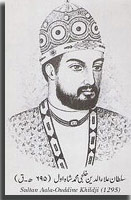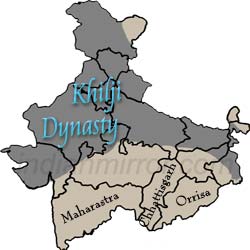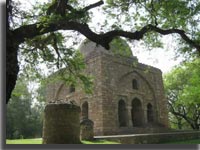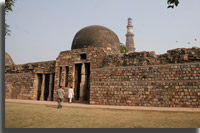History :
The decline of the Slave dynasty, made Delhi Sultanate even more fragile and instable due to the numerous revolts and internal aggression. And this started the Khilji dynasty with the crowning of Jalaluddin Khilji by the nobles in the year 1290 A.D. Jalaluddin Khilji was the first Indian ruler of the Khilji dynasty, who ruled from 1290 - 1294 and invaded India by building his capital in Delhi, though he never really ruled from there. His capital was constructed at Kilokhri where he ruled for around 6 years.

Ala-ud-din Khilji was the second ruler of the Khilji dynasty, whose real name was Juna Khan and he ruled India from 1296-1316. He killed Jalal-ud-din Khilji and then announced himself as the ruler of Delhi. Alauddin Khilji conquered the territory of Gujarat. Around 1301 A.D, he captured Ranthambhor and murdered the Rajput Hamir Deva. Then defeated Rana Rattan Singh and captured Chittoor. By 1305, he captured territories like Malwa, Ujjain, Mandu, Dhar and Chanderi but couldn't capture Bengal. He had conquered almost entire north India by the year 1311 and established his kingdom successfully. Expanding his territory into the peninsular India within a short span of time he died on January 1316 due to an acute health condition.

Place |
Gujarat, Malwa, Ujjain |
Period |
1201 - 1390 AD |
Language |
Persian and Arabic |
Religion |
Sunni Islam |
Kings |
Jalal ud-din Firuz Khilji, Ala-ud-din Khilji, Qutb-ud-Din Mubarak Shah
|
Ala-ud-din began a series of reforms which could curb such activity as he felt. He took away land grants from many of his courtiers, officers and re-organized revenue administration. There was a fixed rate of land revenue, 50 percent of the standing crop which was in reality a much better deal for the poor peasants, who had currently being paying numerous taxes to various officials.
The rulers also organized a large standing army for the defence and also to provide guaranteed food supply to the capital. Alcohol was banned and the courtiers were not permitted to celebrate private meetings or parties. Ala-ud-din appointed spies all over the kingdom to keep him informed about the developments that were taking place. He implemented startling economic reforms, although their effects were probably restricted to Delhi and the 100 mile radius around it.

Alauddin's most trusted noble was Malik Kafur. After Alauddin`s death, he managed to control the situation and made Shahab-ud-din Umar as the king. However Malik Kafur`s own agent killed him. After Malik Kafur, Qutb-ud-din Mubarik Shah another son of Alauddin killed Umar became the Sultan in 1316. During his rule the power was actually in the hands of Khusraw Khan, a lowborn Hindu slave who used to spend time in drinking and womanizing. Khusraw killed Mubarik and declared himself as the Sultan. This led to an end of the Khilji Dynasty.
Contribution to the Indian Society

This was one of the four grand gateways. Some other structures built by Khiljis were the city wall of Siri, the tomb of Alauddin Khilji and the `Madrasa`. The economic reforms by Alaudiin Khilji was undoubtedly a remarkable contribution to the Indian economy. It can be said that the coming of Khaljis to power was more than just being a dynastic change.


